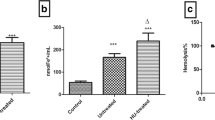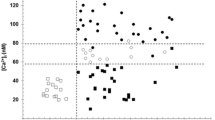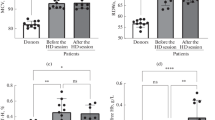Abstract
An increased oxidative stress and a decreased life span of erythrocytes (RBCs) are reported in patients with diabetes. Aim of this study was to assess in RBCs from patients with type 2 diabetes whether downstream effector mechanisms of apoptosis, such as activation of caspase-3, is operative, and whether an iron-related oxidative imbalance, occurring inside RBCs and in plasma, could be involved in caspase-3 activation. In 26 patients with type 2 diabetes and in 12 healthy subjects, oxidative stress was evaluated by means of different markers; non-protein-bound iron, methemoglobin and glutathione were determined in RBCs, and non-protein-bound iron was also determined in plasma. Erythrocyte caspase-3 activation was evaluated by an immunosorbent enzyme assay. Arterial hypertension, demographic and standard biochemical data were also evaluated. The results show, for the first time, that type 2 diabetic RBCs put into motion caspase-3 activation, which is significantly higher than in control RBCs. Such an effector mechanism of “eryptosis” was positively correlated to blood glucose levels and to the increased plasma NPBI level. Caspase-3 activation was also positively correlated to occurrence of arterial hypertension. The results suggest that an extracellular oxidative milieu can be responsible for erythrocyte caspase-3 activation in patients with type 2 diabetes. In turn, caspase-3 activation can be envisaged as a novel mechanism which, by impairing the maintenance of erythrocyte shape and function, might contribute to the shortened life span of RBCs from patients with type 2 diabetes and to hemorheological disorders observed in these patients.



Similar content being viewed by others
References
Jay D, Hitomi H, Griendling KK (2006) Oxidative stress and diabetic cardiovascular complications. Free Radic Biol Med 40(2):183–192
Sailaja YR, Baskar R, Saralakumari D (2003) The antioxidant status during maturation of reticulocytes to erythrocytes in type 2 diabetics. Free Radic Biol Med 35(2):133–139
Babu N, Singh M (2004) Influence of hyperglycemia on aggregation, deformability and shape parameters of erythrocytes. Clin Hemorheol Microcirc 31(4):273–280
Halliwell B, Gutteridge JMC (1999) Free radicals, other reactive species and disease. In: Halliwell B, Gutteridge JMC (eds) Free radicals in biology and medicine. Clarendon Press, Oxford, pp 617–783
Wautier JL, Wautier MP, Schmidt AM, Anderson GM, Hori O, Zoukourian C, Capron L, Chappey O, Yan SD, Brett J, Guillausseau PJ, Stern D (1994) Advanced glycation end products (AGEs) on the surface of diabetic erythrocytes bind to the vessel wall via a specific receptor inducing oxidant stress in the vasculature: a link between surface-associated AGEs and diabetic complications. Proc Natl Acad Sci USA 91(16):7742–7746
Piccinini G, Minetti G, Balduini C, Brovelli A (1995) Oxidation state of glutathione and membrane proteins in human red cells of different age. Mech Ageing Dev 78(1):15–26
Hornig R, Lutz HU (2000) Band 3 protein clustering on human erythrocytes promotes binding of naturally occurring anti-band 3 and anti-spectrin antibodies. Exp Gerontol 35(8):1025–1044
Turrini F, Mannu F, Cappadoro M, Ulliers D, Giribaldi G, Arese P (1994) Binding of naturally occurring antibodies to oxidatively and nonoxidatively modified erythrocyte band 3. Biochim Biophys Acta 1190(2):297–303
Leoncini S, Rossi V, Signorini C, Tanganelli I, Comporti M, Ciccoli L (2008) Oxidative stress, erythrocyte ageing and plasma non-protein-bound-iron in diabetic patients. Free Radic Res 42(8):716–724
Kuypers FA, de Jong K (2004) The role of phosphatidylserine in recognition and removal of erythrocytes. Cell Mol Biol 50(2):147–158
Jain SK, Palmer M, Chen Y (1999) Effect of vitamin E and N-acetylcysteine on phosphatidylserine externalization and induction of coagulation by high-glucose-treated human erythrocytes. Metabolism 48(8):957–959
Closse C, Dachary-Prigent J, Boisseau MR (1999) Phosphatidylserine-related adhesion of human erythrocytes to vascular endothelium. Br J Haematol 107(2):300–302
Boas FE, Forman L, Beutler E (1998) Phosphatidylserine exposure and red cell viability in red cell aging and in haemolytic anemia. Proc Natl Acad Sci USA 95(6):3077–3081
Bratosin D, Mazurier J, Tissier JP, Estaquier J, Huart JJ, Ameisen JC, Aminoff D, Montreuil J (1998) Cellular and molecular mechanisms of senescent erythrocyte phagocytosis by macrophages. A review. Biochimie 80(2):173–195
Lang KS, Lang PA, Bauer C, Duraton C, Wieder T, Huber SM, Lang F (2005) Mechanisms of suicidal erythrocyte death. Cell Physiol Biochem 15(5):195–202
Zermati Y, Garrido C, Amsellem S, Fishelson S, Bouscary D, Valensi F, Varet B, Solary E, Hermine O (2001) Caspase activation is required for terminal erythroid differentiation. J Exp Med 193(2):247–254
Mandal D, Moitra PK, Saha S, Basu J (2002) Caspase 3 regulates phosphatidylserine externalization and phagocytosis of oxidatively stressed erythrocytes. FEBS Lett 513(2–3):184–188
Matarrese P, Straface E, Pietraforte D, Gambardella L, Vona R, Maccaglia A, Minetti M, Malorni W (2005) Peroxynitrite induces senescence and apoptosis of red blood cells through the activation of aspartyl and cysteinyl proteases. FASEB J 19(3):416–418
Miki Y, Tazawa T, Hirano K, Matsushima H, Kumamoto S, Hamasaki N, Yamaguchi T, Beppu M (2007) Clearance of oxidized erythrocytes by macrophages: involvement of caspases in the generation of clearance signal at band 3 glycoprotein. Biochem Biophys Res Commun 363(1):57–62
Lang F, Gulbins E, Lerche H, Huber SM, Kempe DS, Föller M (2008) Eryptosis a window to systematic disease. Cell Physiol Biochem 22(5–6):373–380
Lang KS, Roll B, Myssina S, Schittenhelm M, Scheel-Walter HG, Kanz L, Fritz J, Lang F, Huber SM, Wieder T (2002) Enhanced erythrocyte apoptosis in sickle cell anemia, thalassemia and glucose-6-phosphate dehydrogenase deficiency. Cell Physiol Biochem 12(5–6):365–372
American Diabetes Association (2006) Nutrition recommendations and interventions for diabetes-2006: a position statement of the American Diabetes Association. Diabetes Care 29(9):2140–2157
Ferrali M, Ciccoli L, Comporti M (1989) Allyl alcohol-induced hemolysis and its relation to iron release and lipid peroxidation. Biochem Pharmacol 38(11):1819–1925
Beutler E, Duron O, Kelly BM (1963) Improved method for the determination of blood glutathione. J Lab Clin Med 61:882–888
Evelyn KA, Malloy HT (1938) Microdetermination of oxyhemoglobin, methemoglobin and sulfhemoglobin in a single sample of blood. J Biol Chem 240(2):551–552
Clementi ME, Giardina B, Colucci D, Galtieri A, Misiti F (2007) Amyloid-beta peptide affects the oxygen dependence of erythrocyte metabolism: a role for caspase 3. Int J Biochemistry Cell Biol 39(4):727–735
Comporti M, Signorini C, Buonocore G, Ciccoli L (2002) Iron release, oxidative stress and erythrocyte ageing. Free Radic Biol Med 32(7):568–576
Kell DB (2009) Iron behaving badly: inappropriate iron chelation as a major contributor to the aetiology of vascular and other progressive inflammatory and degenerative diseases. BMC Med Genomics 2(2):1–79
Fernández-Real M, López-Bermejo A, Ricart W (2002) Cross-talk between iron metabolism and diabetes. Diabetes 51(8):2348–2354
Lee DE, Liu DY, Jacobs DR Jr, Shin H, Song K, Lee IK, Kim B, Hider RC (2006) Common presence of non-transferrin-bound iron among patients with type 2 diabetes. Diabetes Care 29(5):1090–1095
Swaminathan S, Fonseca VA, Alam MG, Shah SV (2007) The role of iron in diabetes and its complications. Diabetes Care 30(7):1926–1933
Ciccoli L, Rossi V, Leoncini S, Signorini C, Paffetti P, Bracci R, Buonocore G, Comporti M (2003) Iron release in erythrocytes and plasma non protein-bound iron in hypoxic and non hypoxic newborns. Free Radic Res 37(1):51–58
Aiken NR, Satterlee JD, Galey WR (1992) Measurement of intracellular Ca2+ in young and old human erythrocytes using 19F-NMR spectroscopy. Biochim Biophys Acta 1136(2):155–160
Romero PJ, Romero EA (1999) Effect of cell ageing on Ca2+ influx into human red cells. Cell Calcium 26(3–4):131–137
Lang F, Lang KS, Lang PA, Huber SM, Wieder T (2006) Mechanisms and significance of eryptosis. Antioxid Redox Signal 8(7–8):1183–1192
Romano L, Scuteri A, Gugliotta T, Romano P, de Luca G, Sidoti A, Amato A (2002) Sulphate influx in the erythrocytes of normotensive, diabetic and hypertensive patients. Cell Biol Int 26(5):421–426
Liu F, Mizukami H, Sarnaik S, Ostafin A (2005) Calcium-dependent human erythrocyte cytoskeleton stability analysis through atomic force microscopy. J Struct Biol 150(2):200–210
Del Bello B, Moretti D, Gamberucci A, Maellaro E (2007) Cross-talk between calpain and caspase-3/-7 in cisplatin-induced apoptosis of melanoma cells: a major role of calpain inhibition in cell death protection and p53 status. Oncogene 26(19):2717–2726
Suzuki Y, Ohkubo N, Aoto M, Maeda N, Cicha I, Miki T, Mitsuda N (2007) Partecipation of caspase-3-like protease in oxidation-induced impairment of erythrocyte membrane properties. Biorheology 44(3):179–190
Kriebardis AG, Antonelou MH, Stamoulis KE, Economou-Petersen E, Margaritis LH, Papassideri IS (2007) Storage-dependent remodelling of the red blood cell membrane is associated with increased immunoglobulin G binding, lipid raft rearrangement, and caspase activation. Transfusion 47(7):1212–1220
Mandal D, Mazumder A, Das P, Kundu M, Basu J (2005) Fas-, caspase 8-, and caspase 3-dependent signaling regulates the activity of the aminophospholipid translocase and phosphatidylserine externalization in human erythrocytes. J Biol Chem 280(47):39460–39467
Kostantinova E, Ivanova L, Tolstaya T, Mironova E (2006) Rheological properties of blood and parameters of platelet aggregation in arterial hypertension. Clin Hemorheol Microcirculation 35(1–2):135–138
Sandhagen B (1999) Red cell fluidity in hypertension. Clin Hemorheol Microcirc 21(3–4):179–181
Mandal D, Baudin-Creuza V, Bhattacharyya A, Pathak S, Delaunay J, Kundu M, Basu J (2003) Caspase 3-mediated proteolysis of the N-terminal cytoplasmic domain of the human erythroid anion exchanger 1 (band 3). J Biol Chem 278(52):52551–52558
Biswas D, Sen G, Sarkar A, Biswas T (2011) Atorvastatin acts synergistically with N-acetyl cysteine to provide therapeutic advantage against Fas-activated erythrocyte apoptosis during chronic arsenic exposure in rats. Toxicol Appl Pharmacol 250(1):39–53
Bennett V, Stenbuck PJ (1980) Association between ankyrin and the cytoplasmatic domain of band 3 protein isolated from the human erythrocyte membrane. J Biol Chem 255(13):6424–6432
Wang KK (2000) Calpain and caspase: can you tell the difference? Trends Neurosci 23(1):20–26
Acknowledgments
This study was supported by a grant from University of Siena (Research Project entitled to L.C.).
Conflict of interest
The authors declare that there are no conflicts of interest.
Author information
Authors and Affiliations
Corresponding author
Rights and permissions
About this article
Cite this article
Maellaro, E., Leoncini, S., Moretti, D. et al. Erythrocyte caspase-3 activation and oxidative imbalance in erythrocytes and in plasma of type 2 diabetic patients. Acta Diabetol 50, 489–495 (2013). https://doi.org/10.1007/s00592-011-0274-0
Received:
Accepted:
Published:
Issue Date:
DOI: https://doi.org/10.1007/s00592-011-0274-0




